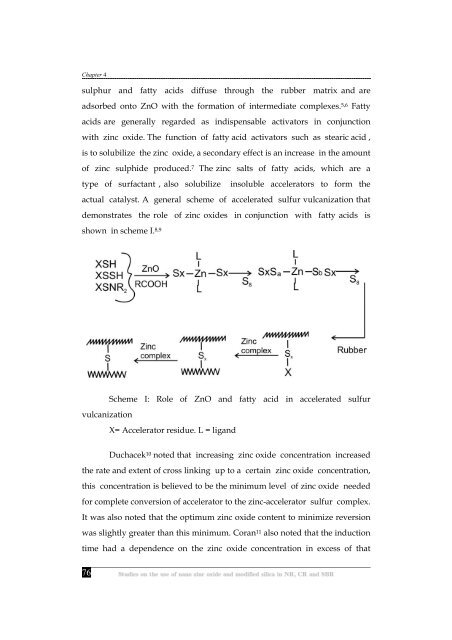Studies on the use of nano zinc oxide and modified silica in NR, CR ...
Studies on the use of nano zinc oxide and modified silica in NR, CR ...
Studies on the use of nano zinc oxide and modified silica in NR, CR ...
Create successful ePaper yourself
Turn your PDF publications into a flip-book with our unique Google optimized e-Paper software.
Chapter 4<br />
sulphur <strong>and</strong> fatty acids diff<strong>use</strong> through <strong>the</strong> rubber matrix <strong>and</strong> are<br />
adsorbed <strong>on</strong>to ZnO with <strong>the</strong> formati<strong>on</strong> <strong>of</strong> <strong>in</strong>termediate complexes. 5,6 Fatty<br />
acids are generally regarded as <strong>in</strong>dispensable activators <strong>in</strong> c<strong>on</strong>juncti<strong>on</strong><br />
with <strong>z<strong>in</strong>c</strong> <strong>oxide</strong>. The functi<strong>on</strong> <strong>of</strong> fatty acid activators such as stearic acid ,<br />
is to solubilize <strong>the</strong> <strong>z<strong>in</strong>c</strong> <strong>oxide</strong>, a sec<strong>on</strong>dary effect is an <strong>in</strong>crease <strong>in</strong> <strong>the</strong> amount<br />
<strong>of</strong> <strong>z<strong>in</strong>c</strong> sulphide produced. 7 The <strong>z<strong>in</strong>c</strong> salts <strong>of</strong> fatty acids, which are a<br />
type <strong>of</strong> surfactant , also solubilize <strong>in</strong>soluble accelerators to form <strong>the</strong><br />
actual catalyst. A general scheme <strong>of</strong> accelerated sulfur vulcanizati<strong>on</strong> that<br />
dem<strong>on</strong>strates <strong>the</strong> role <strong>of</strong> <strong>z<strong>in</strong>c</strong> <strong>oxide</strong>s <strong>in</strong> c<strong>on</strong>juncti<strong>on</strong> with fatty acids is<br />
shown <strong>in</strong> scheme I. 8,9<br />
vulcanizati<strong>on</strong><br />
76<br />
Scheme I: Role <strong>of</strong> ZnO <strong>and</strong> fatty acid <strong>in</strong> accelerated sulfur<br />
X= Accelerator residue. L = lig<strong>and</strong><br />
Duchacek 10 noted that <strong>in</strong>creas<strong>in</strong>g <strong>z<strong>in</strong>c</strong> <strong>oxide</strong> c<strong>on</strong>centrati<strong>on</strong> <strong>in</strong>creased<br />
<strong>the</strong> rate <strong>and</strong> extent <strong>of</strong> cross l<strong>in</strong>k<strong>in</strong>g up to a certa<strong>in</strong> <strong>z<strong>in</strong>c</strong> <strong>oxide</strong> c<strong>on</strong>centrati<strong>on</strong>,<br />
this c<strong>on</strong>centrati<strong>on</strong> is believed to be <strong>the</strong> m<strong>in</strong>imum level <strong>of</strong> <strong>z<strong>in</strong>c</strong> <strong>oxide</strong> needed<br />
for complete c<strong>on</strong>versi<strong>on</strong> <strong>of</strong> accelerator to <strong>the</strong> <strong>z<strong>in</strong>c</strong>-accelerator sulfur complex.<br />
It was also noted that <strong>the</strong> optimum <strong>z<strong>in</strong>c</strong> <strong>oxide</strong> c<strong>on</strong>tent to m<strong>in</strong>imize reversi<strong>on</strong><br />
was slightly greater than this m<strong>in</strong>imum. Coran 11 also noted that <strong>the</strong> <strong>in</strong>ducti<strong>on</strong><br />
time had a dependence <strong>on</strong> <strong>the</strong> <strong>z<strong>in</strong>c</strong> <strong>oxide</strong> c<strong>on</strong>centrati<strong>on</strong> <strong>in</strong> excess <strong>of</strong> that

















